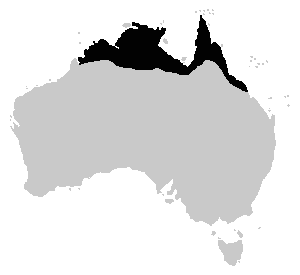Northern dwarf tree frog
The northern dwarf tree frog, dwarf tree frog, lined grass frog, green reed frog, Pandan frog, bicolored grass frog or northern sedge frog (Litoria bicolor)[1] is a tree frog from Australia.[2] It lives all along the coast of northern Australia.[3]
| Northern dwarf tree frog | |
|---|---|

| |
| Conservation status | |
| Scientific classification | |
| Kingdom: | Animalia |
| Phylum: | Chordata |
| Class: | Amphibia |
| Order: | Anura |
| Family: | Pelodryadidae |
| Genus: | Litoria |
| Species: | L. bicolor
|
| Binomial name | |
| Litoria bicolor Gray, 1842
| |

| |
| Range of the northern dwarf tree frog in Australia. | |
| Synonyms[1] | |
| |
Adult frogs are about 3 cm long from nose to rear end. They have a little bit of webbing on their front feet and more webbing on their hind feet.[4] They are green with a bronze stripe over each eye going down their bodies. There is a white stripe under the bronze stripe.[5] The youngest frogs are brown but they turn green as they grow older.[2]
They live in wetlands with large numbers of plants in them, sometimes near humans.[2]
They lay eggs in small groups attached to plants just under the surface of the water. The tadpoles can grow to 5 cm long and take two and a half months to start becoming frogs.[5][2]
Northern Dwarf Tree Frog Media
References
- ↑ 1.0 1.1 "Litoria bicolor (Gray, 1942)". Amphibian Species of the World 6.0, an Online Reference. American Museum of Natural History. Retrieved October 12, 2020.
- ↑ 2.0 2.1 2.2 2.3 "Northern Dwarf Tree Frog". Western Australia Museum. Retrieved June 14, 2020.
- ↑ Jean-Marc Hero; Paul Horner; Dale Roberts; Richard Retallick; Stephen Richards; Allen Allison (2004). "Litoria bicolor". The IUCN Red List of Threatened Species. 2004: e.T41080A10397414. doi:10.2305/IUCN.UK.2004.RLTS.T41080A10397414.en. Retrieved June 14, 2020.
- ↑ "Litoria bicolor". James Cook University. Retrieved June 14, 2020.
- ↑ 5.0 5.1 "Litoria bicolor: Northern Sedge Frog". FrogID. Archived from the original on June 15, 2020. Retrieved June 14, 2020.


